Distinguished Historian returns to The Turning Point
Friederike Baer to speak in Saratoga with Hessians presentation
Dr. Friederike Baer will speak at the 3rd Women in War Symposium on Saturday May 4, 2024. The prestigious event will feature a panel of experts on Women in the Revolutionary War.
Her address will describe the experience of Saratoga, "With the Battle of Saratoga our Misfortunes began, Friederike Riedesel in the War for American Independence".
The Symposium will be held at the Old Saratoga American Legion Post in Schuylerville, NY. The location stands within musket range of Gen. John Burgoyne’s last stand of the Battles of Saratoga, now site of the Saratoga Monument.
Dr. Baer has spoken recently at the Saratoga Battlefield and at important conferences throughout the United States. Her book Hessians was awarded the 2023 Society of the Cincinnati Prize and most recently was a Finalist for the American Battlefield Trust Inaugural Military History Book. Other awards include the 2022 American Revolution Round Table of Philadelphia's Book Award, and Distinguished Historian by The Marshall House Inc., preserving the site of the Baroness’s immersion in combat.
Professor Baer continues to research in preparation of further publication. Her website is https://friederikebaer.com/ .
Details can be found at Saratoga250 https://saratoga250.com/events/annual-women-in-war-symposium/
War Tragedy
A 1932 picture showing the Baroness (Mabel Snyder) and Baron Riedesel (Amer Boivier), reenacted with their three little daughters (Mary Lanier, Margaret Mosher and Faye Mosher) at the Saratoga Battlefield (New York State Archives)
To break the back of the American Revolution, the British planned to divide New England from the other states. Two forces would converge on Albany: the main force from Canada through the Lake Champlain and upper Hudson valleys; the secondary one, under the command of Lt. Col Barry St. Leger, from Oswego in the west.
That force was defeated at Fort Stanwix (now Rome), and the army commanded by Lieutenant General John Burgoyne (coming from Canada) was forced to surrender to the Americans led by General Horatio Gates at Saratoga (now Schuylerville) following three punishing engagements in what are known as the Battles of Saratoga.
Burgoyne’s army of some nine thousand men included nearly three thousand hired German troops commanded by Major General Baron Friedrich Adolf Riedesel. Riedesel was accompanied on this expedition by his wife, Baroness Frederika Charlotte Louise, née von Massow, and their three young daughters, Augusta, Frederika and Caroline.
Mrs. General Riedesel was thirty-two years old at the time. She was a woman devoted to her husband, a lady of remarkable courage and resourcefulness. In her letters and diary (still in publication), her observations of the personalities of the officers and men on both sides and the vicissitudes of war are astute. Her writing style is at once lucid, simple, rhythmical and powerful. She is entitled to be called the first female war historian.
Her letters and diary, which include a number of letters addressed to her by her husband, were published in 1800, appearing in both German and English editions. The excerpts contained in the present narrative are taken from William L. Stone’s translation into English published by Joel Munsell, Albany in 1867.
Following the resounding defeat of the British Army at the Second Battle of Saratoga on October 7th, General Burgoyne decided to retreat whence he came. To deceive the Americans the army was to move by night and so began its march on the 8th. Heavy cold rain, making the narrow road a muddy bog, slowing the movement of cannons and wagons, forced frequent halts.
The retreat dissolved into chaos. Madame Riedesel with her daughters rode in the hungry, drenched van of the weary, dispirited army, while occasionally stifling the screams of little Frederika with her handkerchief so as to not betray their presence to the enemy. Two precious nights and days were consumed in making the journey of less than eight miles to Saratoga (present day Schuylerville).
The baroness resented Burgoyne’s indecision, his unwillingness to abandon the artillery and useless baggage that would make it possible, she reasoned, to escape to Canada. Her opinion was shared by several of Burgoyne’s officers. It was not to be. At last, on the 10th, the army fortified itself as best it could at Saratoga. Here it was that her husband, Major General Riedesel, directed her to seek safety with their children in a house some three hundred yards north of his encampment.
Baroness Riedesel’s account of her six days of refuge in The Marshall House between October 10 and 17, 1777 can no better be related than in her own words.

